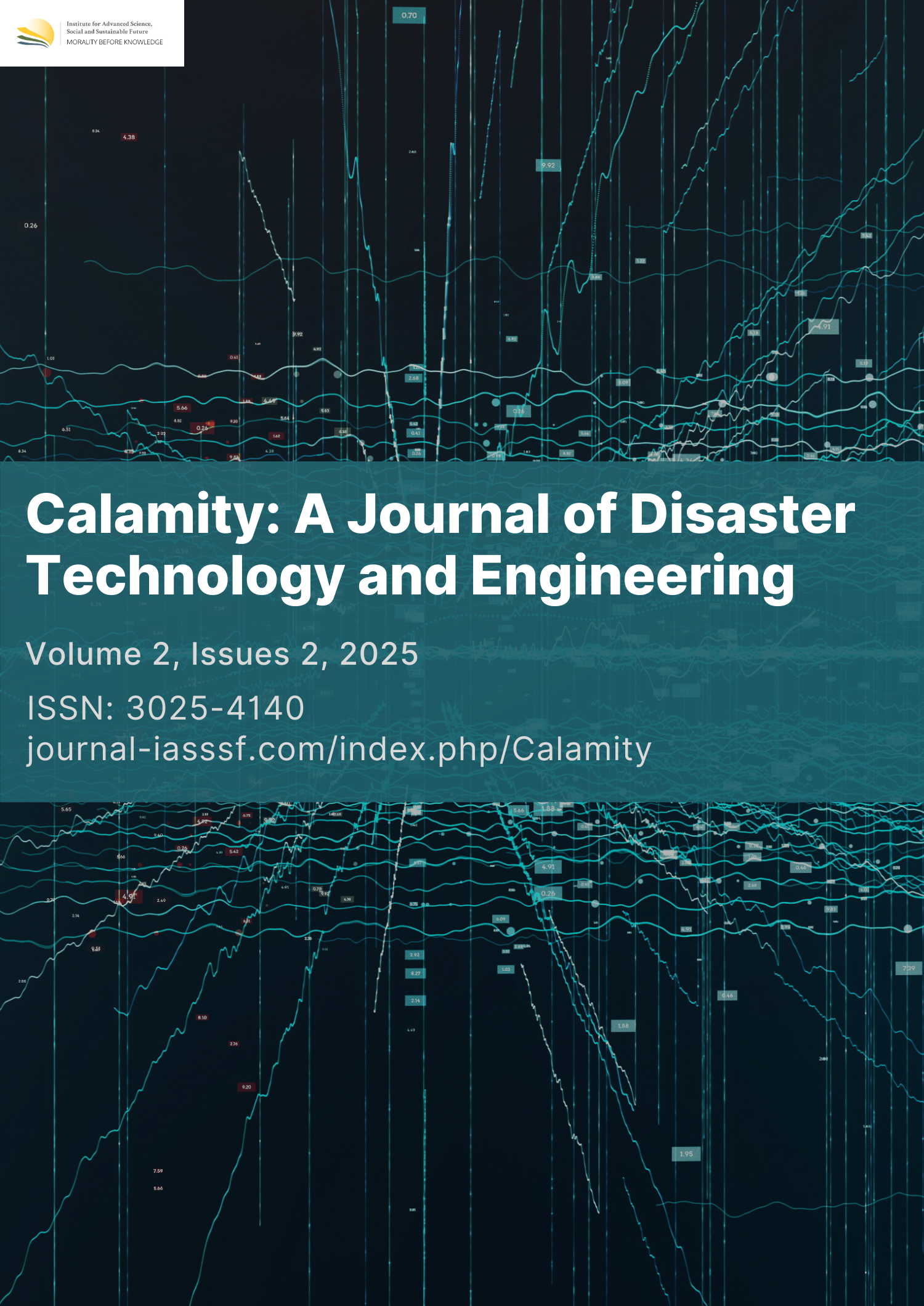Spatial-temporal analysis of built-up land development in landslide-prone areas: Disaster risk assessment
DOI:
https://doi.org/10.61511/calamity.v2i2.2025.1179Keywords:
Ambon, built-up land, land development, spatial analysisAbstract
Background: This study aims to analyze the development of built-up land in landslide-prone areas in Ambon City from 2014 to 2024, considering the increased disaster risk due to unplanned urbanization. Methods: The methods used include spatial temporal analysis utilizing Landsat 7 and Landsat 8 satellite imagery data, as well as landslide risk maps from the National Disaster Management Agency (BNPB). Findings: The results showed that built-up land in high-risk areas increased sharply, from 429.91 hectares in 2014 to 951.65 hectares in 2024, potentially increasing vulnerability to landslides. Conclusion: The study recommends the need for stricter spatial policies and better risk management to control development in landslide-prone areas. In conclusion, wise management and integration of landslide risk maps in urban planning are essential to mitigate the negative impacts of land use change and protect communities from disasters. Novelty/Originality of this article: This study offers a unique contribution by combining spatial-temporal analysis using Landsat satellite imagery with landslide risk maps to assess the impact of unplanned urbanization on landslide-prone areas, providing new insights into the relationship between urban development and disaster risk in Ambon City.
References
Aditian, A., Kubota, T., & Shinohara, Y. (2018). Comparison of GIS-based landslide susceptibility models using frequency ratio, logistic regression, and artificial neural network in a tertiary region of Ambon, Indonesia. Geomorphology, 318, 101-111. https://doi.org/10.1016/j.geomorph.2018.06.006
Asmare, D. (2022). Landslide hazard zonation and evaluation around Debre Markos town, NW Ethiopia—a GIS-based bivariate statistical approach. Scientific African, 15, e01129. https://doi.org/10.1016/j.sciaf.2022.e01129
BNPB. (2023). Indeks Resiko Bencana Indonesia. Badan Nasional Penanggulangan Bencana. https://inarisk.bnpb.go.id/pdf/BUKU%20RBI%202023.pdf
Chen, W., & Li, Y. (2020). GIS-based evaluation of landslide susceptibility using hybrid computational intelligence models. Catena, 195, 104777. https://doi.org/10.1016/j.catena.2020.104777
Harist, M. C., Afif, H. A., Putri, D. N., & Shidiq, I. P. A. (2018). GIS modelling based on slope and morphology for landslide potential area in Wonosobo, Central Java. In MATEC Web of Conferences (Vol. 229, p. 03004). EDP Sciences. https://doi.org/10.1051/matecconf/201822903004
Hehanussa, F. S., Latue, P. C., Rakuasa, H., & Somae, G. (2024). Integration of Remote Sensing Data and Geographic Information System for Mapping Landslide Risk Areas in Ambon City, Indonesia. Journal of Selvicoltura Asean, 1(3), 105-119. https://doi.org/10.70177/jsa.v1i3.1185
Muin, A., & Rakuasa, H. (2023). Spatial Analysis of Landslide Potential Using Modification of the Storie In-dex Method in the Wae Batu Gajah Watershed, Ambon City, Indonesia. International Journal of Scientific Multidisciplinary Research, 1(3), 107-116. http://dx.doi.org/10.55927/ijsmr.v1i3.3625
Rakuasa, H., & Somae, G. (2022). Analisis Spasial Kesesuaian dan Evaluasi Lahan Permukiman di Kota Ambon. Jurnal Sains Informasi Geografi, 5(1), 1-9. http://dx.doi.org/10.31314/jsig.v5i1.1432
Rakuasa, H., Latue, P. C., & Pakniany, Y. (2024). Disaster Mitigation Through Education: A Holistic Approach for Rural Communities. Ulul Albab: Majalah Universitas Muhammadiyah Mataram, 28(2), 77-87. https://doi.org/10.31764/jua.v28i2.23522
Rakuasa, H., & Rifai, A. (2021, April). Pemetaan Kerentanan Bencana Tanah Longsor Berbasis Sistem Informasi Geografis di Kota Ambon. In Seminar Nasional Geomatika Tahun (pp. 327-336). http://dx.doi.org/10.24895/SNG.2020.0-0.1148
Rakuasa, H., Supriatna, S., Tambunan, M. P., Salakory, M., & Pinoa, W. S. (2022). Analisis Spasial Daerah Potensi Rawan Longsor Di Kota Ambon Dengan Menggunakan Metode Smorph. Jurnal Tanah dan Sumberdaya Lahan, 9(2), 213-221. https://doi.org/10.21776/ub.jtsl.2022.009.2.2
Rakuasa, H., Sihasale, D. A., Somae, G., & Latue, P. C. (2023). Prediction of Land Cover Model for Central Ambon City in 2041 Using the Cellular Automata Markov Chains Method. Jurnal Geosains dan Remote Sensing, 4(1), 1-10. https://doi.org/10.23960/jgrs.2023.v4i1.85
Ram, P., & Gupta, V. (2022). Landslide hazard, vulnerability, and risk assessment (HVRA), Mussoorie township, lesser himalaya, India. Environment, Development and Sustainability, 1-29. https://doi.org/10.1007/s10668-021-01449-2
Safriani, E. W., & Wibowo, Y. A. (2022). Preparedness and Adaptive Capacity of Students for Landslide Disasters in Karangkobar, Central Java, Indonesia. KnE Social Sciences, 1-19. https://doi.org/10.18502/kss.v7i5.10536
Salakory, M., & Rakuasa, H. (2022). Modeling of Cellular Automata Markov Chain for predicting the carrying capacity of Ambon City. Jurnal Pengelolaan Sumberdaya Alam dan Lingkungan, 12(2), 372-387. https://doi.org/10.29244/jpsl.12.2.372-387
Septory, J. S. I., Latue, P. C., & Rakuasa, H. (2023). Model dinamika spasial perubahan tutupan lahan dan daya dukung lahan permukiman Kota Ambon tahun 2031. GEOGRAPHIA: Jurnal Pendidikan dan Penelitian Geografi, 4(1), 51-62. https://doi.org/10.53682/gjppg.v4i1.5801
Somae, G., Supriatna, S., Manessa, M. D. M., & Rakuasa, H. (2022, December). SMORPH Application for Analysis of Landslide Prone Areas in Sirimau District, Ambon City. In Social, Humanities, and Educational Studies (SHES): Conference Series (Vol. 5, No. 4, pp. 11-18). https://doi.org/10.20961/shes.v5i4.68936
Souisa, M., Hendrajaya, L., & Handayani, G. (2016, August). Landslide hazard and risk assessment for Ambon city using landslide inventory and geographic information system. In Journal of Physics: Conference Series (Vol. 739, No. 1, p. 012078). IOP Publishing. https://doi.org/10.1088/1742-6596/739/1/012078
Sugandhi, N., Supriatna, S., & Rakuasa, H. (2023). Identification of Landslide Prone Areas Using Slope Morphology Method in South Leitimur District, Ambon City. Jambura Geoscience Review, 5(1), 12-21. https://doi.org/10.34312/jgeosrev.v5i1.14810
Susetyo, J. A., Kurnianto, F. A., Nurdin, E. A., & Pangastuti, E. I. (2022). Landslide Disaster Mapping in Silo District, Jember Regency. In IOP Conference Series: Earth and Environmental Science (Vol. 975, No. 1, p. 012011). IOP Publishing. https://doi.org/10.1088/1755-1315/975/1/012011
Downloads
Published
How to Cite
Issue
Section
Citation Check
License
Copyright (c) 2025 Heinrich Rakuasa

This work is licensed under a Creative Commons Attribution 4.0 International License.
















